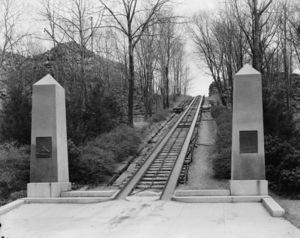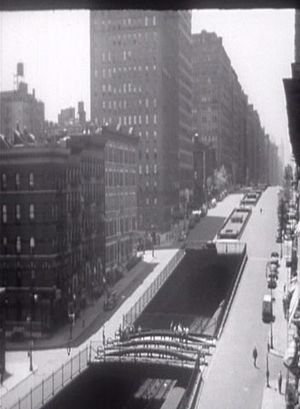Oldest railroads in North America
From TrainSpottingWorld, for Rail fans everywhere
Several railroads have been called the oldest in the United States or North America. Those, as well as other railroads chartered or opened during that time period, are listed below.
Contents
List of railroads
This list is incomplete; you can help by expanding it.
- 1720: A railroad is reportedly used in the construction of the French fortress at Louisburg, Nova Scotia (Brown, Robert R., Canada's Earliest Railway Lines, Railway & Locomotive Historical Society Bulletin #78, October 1949).
- 1764: Between 1762 and 1764 a gravity railroad (Montresor's Farmway) was built by British military engineers at the Niagara Portage in Lewiston, New York.
- 1795: A wooden railway on Beacon Hill in Boston carried excavations down the hill to clear the land for the State House.
- 1799: Boston developers begin to reduce the height of Mount Vernon, prior to building streets and homes. Silas Whitney constructs a gravity railroad to move excavated material down the hill to fill marshy areas to create new land from the Back Bay. (Whitehill, Walter Muir, Boston - A Topographical History, Cambridge, Harvard University Press, 1959, p.62).
- September 1809: An experimental railroad was built next to a Philadelphia tavern by a millwright named Somerville. The track, built for Thomas Leiper, has a grade of 1-1/2 inch to the yard (about 4 %) over its total length (60 yards) and proves satisfactory when tested with a loaded car (Dunbar, Seymour, A History of Travel in America, p. 876-7).
- 1810: The Leiper Railroad connecting Crum Creek to Ridley Creek, Pennsylvania opened in 1810. It closed in 1829 and was replaced by the Leiper Canal, but a railroad once again replaced the canal in 1852. This became the Crum Creek Branch of the Baltimore and Philadelphia Railroad (part of the Baltimore and Ohio Railroad) in 1887. This was the first railroad meant to be permanent, and the first to evolve into a common carrier after an intervening closure. See the 1826 Granite Railway for comparison.
- 1811: George Magers designs and builds a 1-mile wooden gravity railroad between a gunpowder mill and its powder storage bunker at Falling's Creek, Virginia (Dunbar, p.878-9, quoting Thomas McKibben of Baltimore in the American Engineer, 1886).
- 1815: New Jersey grants a charter on February 6, 1815 for a company to "erect a rail-road from the river Delaware near Trenton, to the river Raritan, at or near New Brunswick", as proposed by John Stevens (1749-1838). This was the first railroad chartered in the United States, but the New Jersey Railroad Company never built the railway due to an inability to attract financial investors.
- 1816: A railroad is reportedly used at Kiskiminetas Creek, Pennsylvania (Dunbar, p.880).
- 1818: An iron-smelting funace at Bear Creek, Armstrong County, Pennsylvania reportedly has a wooden railroad in operation (Dunbar, p.880).

The incline section of the Granite Railway, photograph taken in 1934.
- 1826: The Granite Railway in Massachusetts was incorporated March 4, 1826 by Thomas Handasyd Perkins and Gridley Bryant. Construction began on April 1, 1826, and operations began on October 7, 1826. It later became a branch of the Old Colony and Newport Railroad, which was later absorbed into the New York, New Haven and Hartford Railroad. This is often called the first commercial railroad in the U.S., as it was the first to evolve into a common carrier without an intervening closure. See the 1810 Leiper Railroad for comparison.
- 1829: The Delaware and Hudson Canal Company's gravity railroad in northeast Pennsylvania opened, with the Stourbridge Lion, the first locomotive to run on rails in the United States, first operating on August 8. The canal company, chartered in 1823, called itself "America's oldest continually operated transportation company".
- 1830: The Baltimore and Ohio Railroad was chartered February 23, 1827, and construction began July 4, 1828. The first 1.5 mile section opened January 7, 1830; the line opened to Ellicott's Mills May 22, 1830, with regular passenger service beginning May 24.[1] This was the first railroad that evolved into a major system rather than being gobbled up by another, and was probably the first passenger railroad.
- 1830: The South Carolina Canal and Rail Road Company was chartered December 19, 1827, construction began January 9, 1830, and the first section opened December 25, 1830. This was the first railroad to use steam locomotives regularly.[2] It later became part of the Southern Railway, now part of Norfolk Southern.
- 1830: The Tuscumbia-Courtland-Decatur Railroad, the first railroad chartered/constructed west of the Appalachian Mountains , built connecting the two Alabama cities of Tuscumbia, and Decatur.
- 1831: The Pontchartrain Rail-Road, chartered the previous year, begins steam locomotive traffic between the Mississippi River front of New Orleans, Louisiana and Lake Pontchartrain on 23 April. [3]
- 1831: The New Castle and Frenchtown Turnpike and Rail Road opens in Delaware and Maryland, originally using horse power.
- 1831: The Chesterfield Railroad began operations by September 1831 in Chesterfield County, Virginia.
- 1831: The Mohawk and Hudson Railroad between Albany and Schenectady, New York was chartered in 1826. Construction began August 1830 and the railroad opened September 24, 1831. It later became part of the New York Central Railroad.
- 1832: The New York and Harlem Railroad was incorporated April 25, 1831, and the first section opened November 26, 1832. This was probably the first street railway in the U.S.
- 1834: The entire 29 mile section of the Ithaca and Owego Railroad opens on April 1 1834, with both passenger and freight service.
- 1834: The entire Philadelphia and Columbia Railroad opens on April 15 1834.
- 1835: The Boston and Lowell Railroad opens.
- 1836: The Decatur-Courtland-Tuscumbia Railroad built in North Alabama.
- 1836: The Lake Wimico and St. Joseph Canal and Railroad was the first steam railroad in Florida, opening on September 5.
- 1836: The Champlain and St. Lawrence Railroad opens in Quebec, Canada.
Tunnels
- 1834: The Allegheny Portage Railroad opened in March 1834, including the Staple Bend Tunnel, the first railroad tunnel in the U.S., completed in June 1833. Trains stopped running through it in 1857, and it is now part of the Allegheny Portage Railroad National Historic Site.
- 1837: The New York and Harlem Railroad began running through the Yorkville Tunnel on October 26, 1837. It was absorbed in the 1870s by the longer and wider Park Avenue Tunnel, and is used by all Metro-North Railroad commuter trains. The old tunnel carries the two center tracks, and two new tunnels carry outer tracks.
- 1839: The Norwich and Worcester Railroad opened in 1839 or 1840 through Bundy Hill Tunnel north of Norwich, Connecticut. This is the oldest tunnel still in use in its original form in the U.S.
West of the Mississippi River
- 1841: The Red River Railroad in Louisiana was operational by 1841. [4]
- 1852: The first section of the Pacific Railroad, later part of the Missouri Pacific Railroad, opened near St. Louis, Missouri.
References
General information
- First Railroads in North America
- Library of Congress - History of Railroads and Maps
- Railroad History Database
- William D. Middleton, Where is America's oldest railroad tunnel?, Trains May 2002
Specific railroads
- First Permanent Railroad In The U. S. And Its Connection To The University Of Pennsylvania (Leiper Railroad)
- The First Railroad in America 1826-1926: A History of the Origin and Development of the Granite Railway at Quincy, Massachusetts

